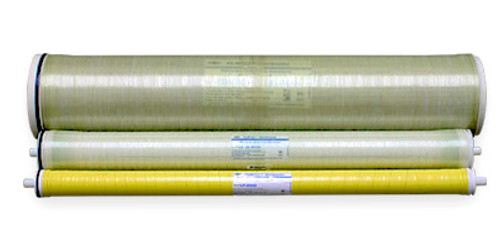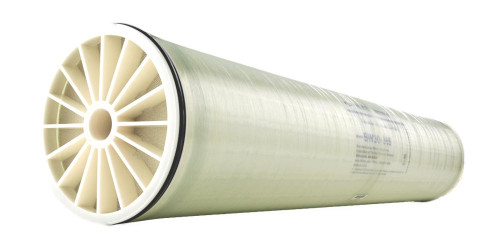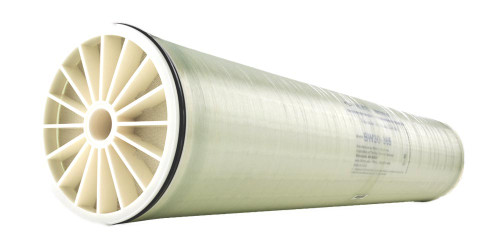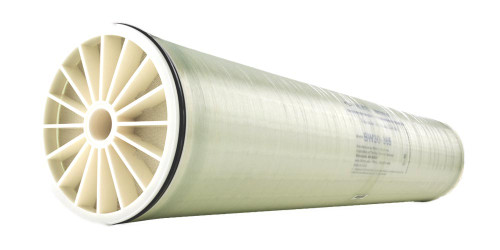DUPONT FILMTEC BW30 XHR PRO 400/34 High Durability, Organic Fouling Resistant Brackish Water RO Element with iLEC™ Technology.
Important Information
Proper start-up of reverse osmosis water treatment systems is essential to prepare the membranes for operating service and to prevent membrane damage due to overfeeding or hydraulic shock. Following the proper start-up sequence also helps ensure that system operating parameters conform to design specifications so that system water quality and productivity goals can be achieved.
Before initiating system start-up procedures, membrane pretreatment, loading of the membrane elements, instrument calibration and other system checks should be completed.
Please refer to the application information literature entitled “Start-Up Sequence” (Form No. 609-02077) for more information.
Operation Guidelines
Avoid any abrupt pressure or cross-flow variations on the spiral elements during start-up, shutdown, cleaning or other sequences to prevent possible membrane damage. During start-up, a gradual change from a standstill to operating state is recommended as follows:
- Feed pressure should be increased gradually over a 30-60 second time frame.
- Cross-flow velocity at set operating point should be achieved gradually over 15-20 seconds.
- Permeate obtained from first hour of operation should be discarded.
General Information
- Keep elements moist at all times after initial wetting.
- If operating limits and guidelines given in this bulletin are not strictly followed, the limited warranty will be null and void.
- To prevent biological growth during prolonged system shutdowns, it is recommended that membrane elements be immersed in a preservative solution.
- The Customer is fully responsible for the effects of incompatible chemicals and lubricants on elements.
- Maximum pressure drops are 15 psi (1.0 bar) per element or 50 psi (3.4 bar) per multi-element pressure vessel (housing) whichever value is more limiting.
- Avoid static permeate-side backpressure at all times.
Specifications
| Product | Part number | Active area ft2 (m2) | Feed spacer thickness (mil) | Permeate flow rate gpd (m3/d) | Stabilized salt rejection (%) | Minimum salt rejection (%) |
|---|---|---|---|---|---|---|
| BW30 XHR PRO 400/34 | 315924 | 400 (37) | 34 | 11,500 (44) | 99.65 | 99.4 |
| Solute | NH4+ | NO3- | SiO2 | Boron |
|---|---|---|---|---|
| Typical rejection(%) | 98.8 | 98.2 | 99.8 | 80 |
DUPONT FILMTEC™ BW30 XHR PRO 400/34 has an optimized design and materials of construction to create a durable, high rejection and high productivity element to purify waters with biological and organic fouling tendencies. Incorporating Dow’s innovative and proprietary BW30XFR 400/34i membrane sheet with advanced organic fouling resistance and cleanability, this reverse osmosis (RO) element combines the best features of fouling resistance and durability; with the cleanability of an optimized 34 mil feed spacer, to improve cleaning effectiveness. All this while delivering high element performance over the life of the spiral wound brackish water RO element.
- Effective and efficient cleaning of biofilm, organic compounds and scale, achieved through the widest pH cleaning range (pH 1 – 13), made possible by the most advanced DUPONT FILMTEC™ RO membrane sheet available today.
- Produces 10 percent more water compared to the BW30-400/34i or BW30-400/34i FR element at the same operating pressure and higher rejection, enabling lower capital expense for new systems, or increased water production in an existing system.
- Reliable system integrity, resulting in reduced system operating costs with the iLEC™ technology (interlocking end-caps), minimizing the risk of o-ring leaks that can contribute to poor water quality.
Operating Limits
- Membrane Type Polyamide Thin-Film Composite
- Maximum Operating Temperature 113°F (45°C)
- Maximum Operating Pressure 600 psig (41 bar)
- Maximum Pressure Drop 15 psig (1.0 bar)
- pH Range, Continuous Operation 2 - 11
- pH Range, Short-Term Cleaning (30 min.) 1 - 13
- Maximum Feed Silt Density Index SDI 5
- Free Chlorine Tolerance <0.1 ppm
- Industrial water demineralization
- Production of municipal drinking water
- Water reuse
 ENGLISH
ENGLISH ESPAÑOL
ESPAÑOL العربية
العربية PORTUGUÉS
PORTUGUÉS FRANÇAIS
FRANÇAIS










